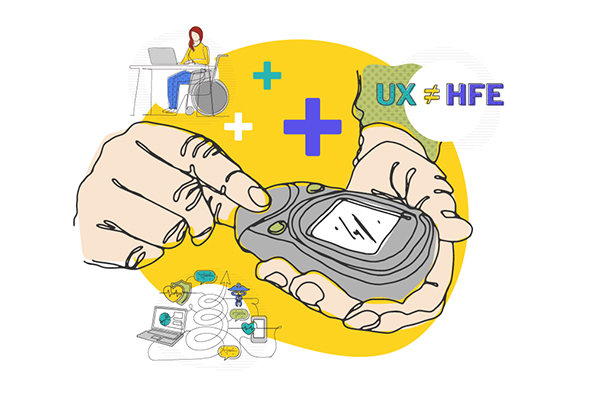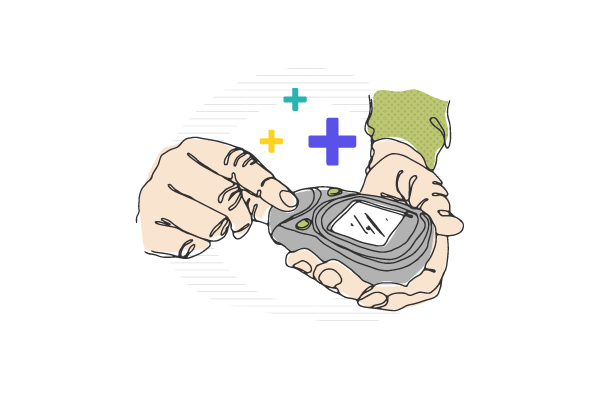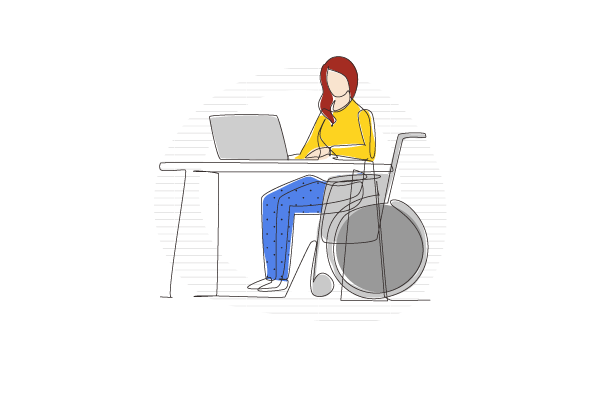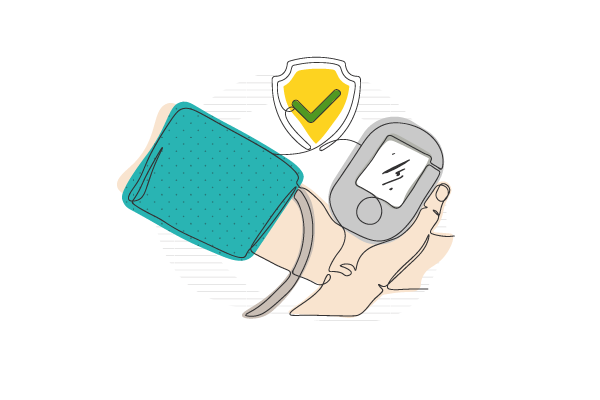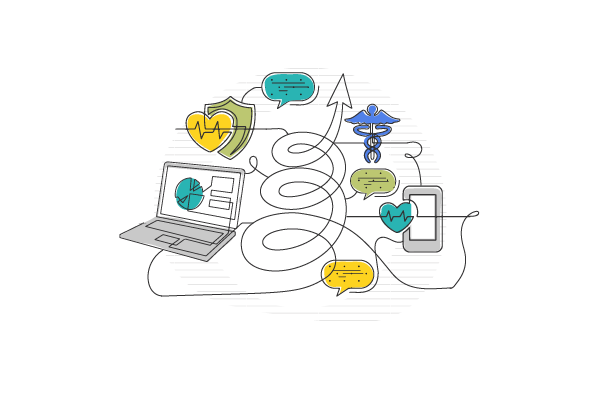The Benefits of User Experience Design (UxD) and Human Factors Engineering (HFE) Collaborating on Medical Device Design and Development.
In this blog, we examine the benefits of deep collaboration between the practices of User Experience Design (UXD) and Human Factors Engineering (HFE) during the medical device design and development process and how it improves user satisfaction and patient outcomes.
In the MedTech industry, designing for safety takes precedence over designing for the user experience—driven by increasing time-to-market pressures on the medical device and development process, as well as regulatory approval. There are no such regulatory requirements around pure usability for a medical device with no patient safety risk. As a result, medical device design and development activities don’t currently give the necessary importance to the user experience beyond safety and mitigating use errors. Although safety is a priority—and rightly so—the end user must be the focal point to improve usability and the overall device experience. Better user experiences for new medical devices ensure better treatments and patient outcomes, supporting a medical device manufacturer’s commercial goals, such as adoption, compliance, innovation, end-user satisfaction, and greater brand awareness.
Medical devices must be safe, effective, and user-friendly. Patients and users need to feel connected to the products they use beyond the required safety requirements and functionality. Deep collaboration between User Experience (UX) and Human Factors (HF) professionals is paramount to designing devices intended for end-users with their particular skills and nuances. By taking an interdisciplinary approach to product development and usability engineering, you ensure that medical devices are designed for the end user and their context of use—this integrated process results in safe, effective, intuitive devices designed with empathy.
“You’ve got to start with the User Experience and work back toward the technology—not the other way round.” Steve Jobs, CEO, Apple.
What is the Difference Between Medical Device UX Design and Human Factors Engineering?
User Experience Design (UxD) and Human Factors Engineering (HFE) are frequently used interchangeably in medical device design and development. While each discipline focuses on generating positive patient and Healthcare Professional (HCP) experiences, UxD and HFE are distinct from one another and sharply defined by their fundamental differences.
Medical Device UX Design focuses on the mechanisms by which end users interact with the device—designing medical devices that are less error-prone, intuitive, and engaging for end users by assessing all user interactions with the products. UX designers take into account user needs, perceptions, behaviors, and beliefs in product designs that are usable, functional, and efficient and eliminate the hurdles to compliance.
HFE centers around understanding how use-related factors impact device use and is the application of knowledge about human behavior, abilities, limitations, and other characteristics of medical device users. The primary focus of HF is risk management to eliminate adverse events and reduce the incidence of use errors to produce Safer, more effective, and more intuitive device interactions through user-centered design, contextual inquiry, formative evaluations, summative validation studies, and advising. The practice of HF helps solve usability issues that could otherwise cause device and treatment delays that affect patients and the sponsoring medical device manufacturer’s revenue and market share.
The critical difference is that HFE is distinguished by its focus on “safe and effective use.” UX is broader because it weighs value, desirability, and factors beyond efficiency and safety. The end goal of both disciplines is similar. However, the training and methodologies needed by each to achieve a positive patient experience for the intended users and providers are separate disciplines, no matter how closely related and beneficial they are to each other.
The Benefits of UX and HF Collaboration on Medical Device Design and Development
Medical device design and development is a complex process. It can take months to create simple devices and years for more sophisticated ones. Getting things right the first time — including design decisions and Food and Drug Administration (FDA) approval — is critical. Bringing the best of both practices together ensures that devices are easier to use with fewer use errors from poor usability, increasing satisfaction and safety to deliver better patient outcomes. Seamlessly integrating the practices of UX and HF manufacturers of medical products significantly increase the odds of successful market adoption and improved business results. This interdisciplinary approach bridges the gap between medical technology and its users and delivers the following benefits:
1) More inclusive device design
Through a user-centered approach, the disciplines of HFE and UX work cooperatively to focus on the preferences and needs of diverse user groups, including individuals with different disabilities, abilities, and challenges. The interplay between the two practices is critical in medical device design and development to create devices with greater inclusivity and ease of use.
Working alongside UX designers and with FDA guidance, HF professionals work to understand the user group’s capabilities/limitations and needs, driving requirements early in the design process— conducting user research, documenting a product’s design criteria, and informing its form factor, information architecture, and interaction paradigms. UX designers use this data to create meaningful and relevant experiences from first use through to help, service, and maintenance— planning and specifying exactly how the product or system will work—producing iterative design solutions and prototypes and evaluating them against requirements. Both disciplines inform each other to make devices more accessible to a wide range of users, regardless of their cognitive and physical abilities or limitations.
2) Greater user adoption and comfort
By collaborating closely together on medical device design and development, UX and HF professionals ensure that devices meet requirements and are tailored to user needs. Contextual Inquiry is a critical activity providing a platform for close collaboration between the two disciplines. Through observation in the use environment, in-depth interviews, and collaborative interpretation, Contextual Inquiry uncovers hidden insights about patients, users, and intended use that is unavailable through other research methods. It Identifies the problems to solve and informs everything from device ergonomics and functionality to the physical configuration of products and user interface design.
Ease of use is a massive driver for patient and HCPs adoption. Patients today are active participants in their healthcare, and you need to consider that patients will become active, empowered consumers of the solution. It’s no longer enough to get new devices into prescribers’ hands — you also need to create patient demand by directly addressing their needs. It takes the integration of HFE’s scientific knowledge about human capabilities and limitations to design, with a UX designer’s focus on designing everything the user comes into contact with, even emotionally, to develop medical devices that are intuitive and comfortable to use. This integrated approach drives adoption by converging functions and feelings to holistically improve the patient experience.
3) Increased Device Trust
Merging the talents, skills, and training of UX and HF teams increases device trust by taking a user-centered approach to developing personalized health experiences that are more effective, reliable, and easy to use. HF professionals engender trust with end-users in the device’s design by identifying use-related risks and the critical tasks that, if performed incorrectly or not performed at all, would or could cause harm. UX designers build on this vital foundation through user research and analysis, creativity, and iterative expert review to develop medical device interfaces that are navigable and intuitive, boosting a user’s confidence in their ability to use the device, as well as in the effectiveness of the device itself. In addition, UX and HF teams also consider the ergonomics of devices, providing medical professionals with equipment designed to work with them, not against them, increasing comfort and preventing injury.
4) Reduced device fear and intimidation
A patient’s emotional response to a medical device is an essential medical issue that has, to date, been inadequately addressed. With more medical technology moving into the hands of the patients themselves, thinking about the emotional response a device might create has never been more critical for medical professionals and patients. Clinical efficacy has understandably always been priority one, but efficacy has increasingly become the price of entry, with a greater commercial emphasis now placed on usability and aesthetics. Medical devices that do not remind patients of their disease state or treatment environment are less intimidating; HCPs want to work with devices that look clean and easy to use. Patients and users want to feel smart and competent, not overwhelmed or ill-equipped to use the device. Developing a medical device that generates a positive emotional response, rather than one of fear and intimidation, is not a concept with which many medical device manufacturers are familiar. Further, they have no idea how to address this during the medical device design and development process.
Integrating UX and HF early in the generative design phases is critical to understand what appeals to your users. Apart from its functionality, a product’s appeal comes from how it makes us feel about ourselves—a component of which is the emotions it elicits within us. UX researchers are experts at investigating medical devices within the context of a user’s everyday life, shadowing and observing them to understand how they use (and in many cases do not use) the device to understand the “why” behind their behaviors. Adopting a human-centered approach reduces device fear and intimidation by providing UX and Industrial Designers and HFEs with the various elements of design needed to elicit a positive emotional response. These design elements may be using simple language, developing intuitive controls, or creating clear Instructions for Use (IFU).
When UX and HF are involved in the generative design phase of the medical device design and development process, it ensures the final product will require less training time while seeing fewer use errors and complaints, decreased device liability, and faster regulatory approval.
5) Simplify and Manage Complexity
Designing for the MedTech industry’s rapidly evolving technology, safety, and regulatory environment is highly complex. With this increasing complexity comes a need to improve the user experience by developing intuitive, well-designed medical devices for safe and effective use. Poor device usability can cause harm and lead to device recalls. Medical error (251k per annum) is now the third leading cause of death in the United States after Heart Disease (611k) and Cancer (585k)1, with more than one-third of medical device incident reports involving use error and over 50% of device recalls being traced back to the design of the user interface. Intuitive, well-designed medical device user interfaces are essential. Fortunately, UxD, driven by human factors engineering (HFE) r and usability requirements, has become a foundational component in managing device complexity through user-centered design.
In medical device design, this means combining mechanical and electrical components with software applications in a way that is intuitive and easy to use. Using HFE and UxD to manage the complexity inherent in medical device design begins with generative HFE user studies—or Contextual Inquiry (CI) —to understand specific interface needs, expectations, and aspirations to establish user requirements that drive subsequent design objectives. Working collaboratively with UX designers throughout the design process HFEs act as design-agnostic observers, objectively observing user interaction and applying unbiased analysis to the next redesign with an unwavering emphasis on ease of use, effectiveness, and safety. Together, HFEs and UX designers pinpoint components or elements of the device that may be challenging or overwhelming for users. Successfully managing complexity in medical devices requires a clear focus on HF principles realized through an iterative UX design process of usability testing, incorporating user feedback, and identifying and addressing potential risks.
Conclusion: An Integrated HFE and UxD Approach Brings Value to the Medical Device Design Process
By working together collaboratively throughout the medical device design and development process HFEs and UX designers create safer, more effective, and intuitive medical devices, improving patient outcomes with increased user satisfaction and enhanced healthcare experiences. This human-centered design approach manages complexity, reduces device intimidation and fear, and increases user adoption. HFEs and UX Designers also reduce the risk of use errors, increase the likelihood of first-time regulatory approval, and minimize the potential for product recalls and complaints. Additionally, when companies overlook HFE and focus solely on the “what” and not the “why,” the burden of HFE lands on the product development team to deliver products based on subjective stakeholder assumptions, not evidence-based human insight.
At THRIVE, our interdisciplinary approach to medical device design and development involves social scientists, design researchers, HF, and UX professionals informing one another to deliver human-centered medical devices. If it’s your first time applying Human Factors and you need a comprehensive end-to-end Human Factors program, we’ll scope it and conduct the activities on your behalf, leaving you time and resources to focus elsewhere. If you’re a resource-constrained HFE professional, we’ll provide the teamwork, collaboration, and support to help you meet your goals. Or, if you want a final sanity check to ensure you’ve met the latest and greatest expectations, we’ll do that too. Contact us today to get the conversation started.
____________________________________
- Martin A Makary, Michael Daniel. BMJ 2016; 353: i2139 (03 May 2016)

